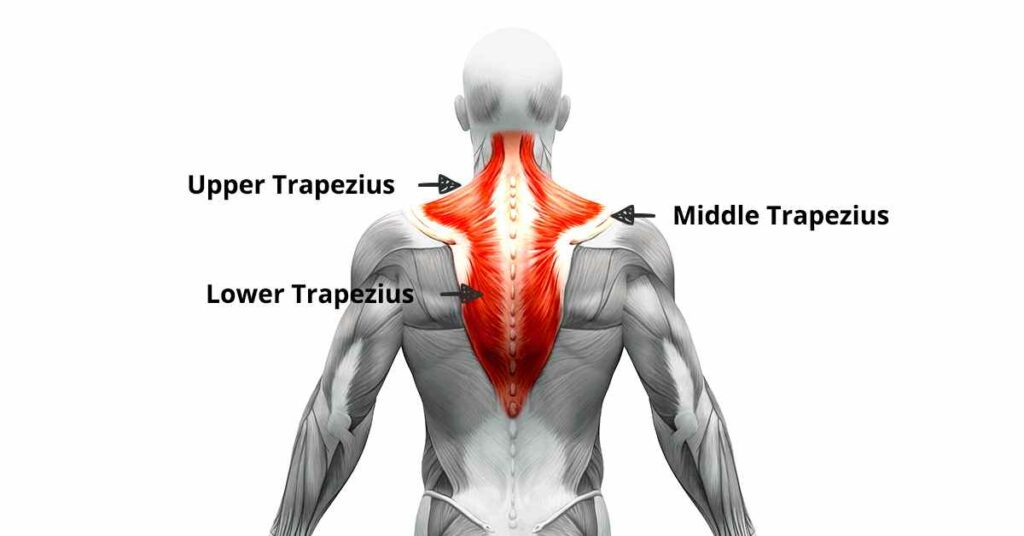Do you wake up in the morning with a stiff and sore trapezius muscle? If so, you’re not alone. This is a common problem that many people experience. In this blog post, we will discuss what causes trapezius pain after sleeping, and we will also provide some tips on how to alleviate the pain.
Contents
What Is Trapezius Pain?

The trapezius muscle is a large, triangular muscle that extends from the base of the skull to the middle of the back. The muscle is responsible for moving the shoulder blades and supporting the neck. Trapezius pain is a common type of muscle pain that occurs when the trapezius muscle is tense or strained. The pain may be sharp and localized to the muscle, or it may be a dull, aching pain that radiates to the neck, shoulders, or upper back.
What Causes Trapezius Pain?
There are several possible causes of trapezius pain. Poor posture, repetitive motions, and stress can all contribute to muscle tension and strain. Other causes of trapezius pain include injury, inflammation, and nerve compression.
How Can You Manage Trapezius After Sleeping?

There are various ways through which trapezius pain will manage. They are as follows:
Trapezius stretches
This will help in lengthening the trapezius muscle and thereby reducing the pain. For example, you can try this stretch:
Stand up straight and pull your shoulder back.
Bend your head to the right until you feel a stretch in the left side of your neck.
Hold for 30 seconds and repeat on the other side.
Massage
Massaging the affected area with any essential oil will help in relaxing the muscle and reducing the pain. It includes:
Swedish massage: This is a gentle form of massage that uses long strokes and light pressure to relax the muscles.
Deep tissue massage: This type of massage uses more pressure and slow strokes to reach the deep layers of muscle tissue. It is helpful in relieving chronic pain.
Trigger point massage: This massage therapy is used to release the muscle knots that cause pain in the trapezius muscle.
Ice pack
Applying ice packs on the affected area for 15 minutes will also help in reducing the pain and swelling.It includes using an ice pack in the area.
Pain relievers
You can also take over-the-counter pain medications like ibuprofen or acetaminophen to help relieve the pain.
Heat pack
Applying heat packs on the affected area for 15 minutes will help in relaxing the muscle and reducing the pain.
Trapezius exercises
Exercises like shoulder shrugs and rows will help in strengthening the trapezius muscle and thereby reduce the pain.
For example, you can do shrugs by holding a weight in each hand and raising your shoulders towards your ears. You can do rows by holding a weight in each hand and pulling your elbows back. These exercises should be done 3 times a week for best results.
Adequate rest
Taking adequate rest will help in reducing the stress on the muscle and thereby reduce the pain. For example, if you have been working on the computer for long hours, take a break every 20-30 minutes and do some neck and shoulder exercises.
Proper posture
Maintaining a proper posture while sitting, standing or sleeping will help in reducing the strain on the muscle and thereby reducing the pain.
Avoiding triggering activities
Avoiding activities that trigger the pain will help in reducing the pain. For example, if neck extension or rotation increases the pain, then limit these motions. Also, avoid carrying heavy objects as they can add strain to the trapezius muscle.
Ergonomic adjustments
Adjusting your workstation to better fit your body can help reduce tension in the trapezius muscle. Here are a few tips:
- Use a chair that supports your back and allows your feet to rest flat on the floor.
- Position your computer screen so you don’t have to strain your neck to see it.
- Take regular breaks to walk around and stretch your body.
Physical therapy
Physical therapy will help in reducing the pain and restoring muscle function. The therapist will first assess the cause of your pain and then design a treatment plan accordingly. The treatment may include exercises, stretching, ice or heat therapy, and massage.
Surgery
In some cases, surgery may be required to release the muscle tissue that is entrapping the nerves. However, this is usually only recommended if other treatments have failed to provide relief.
If you are suffering from trapezius pain, it is important to seek treatment as soon as possible. Early treatment can help prevent the condition from worsening and causing further damage to the muscle.
Tips For Sleeping
Do you often wake up with pain in your trapezius muscle? If so, you’re not alone. Many people suffer from this common condition, which can be caused by a variety of factors.
There are a few things you can do to help ease the pain and get a better night’s sleep.
- First, try to sleep on your back or side instead of your stomach. This will help take the pressure off of your trapezius muscle.
- If you often sleep on your stomach, you can try placing a pillow under your pelvis to help tilt your hips and take the pressure off of your lower back and trapezius muscle.
- You may also want to try placing a pillow under your head to support your neck. This will help keep your spine in alignment and prevent your trapezius muscle from being strained.
- In addition, it’s important to practice good posture during the day. Be sure to sit up straight and avoid slumping. Use a chair that supports your back, and don’t forget to stretch your trapezius muscle regularly.
If you suffer from chronic pain, you may also want to consult with a doctor or physical therapist. They can help you find specific exercises that will stretch and strengthen your trapezius muscle.
With a little effort, you can find relief from trapezius pain and get a better night’s sleep. Try these tips and see how they work for you.
Conclusion
It may be concluded that trapezius pain after sleeping is a common problem with various possible causes. However, most often the pain is due to poor sleep posture or muscle tension. To prevent trapezius pain, it is important to maintain good posture and practice stress-relieving exercises. If the pain persists, consult a doctor to rule out any serious underlying conditions.
Physical Therapy help patients recover from pain. If you’re experiencing Back pain, Shoulder pain, Knee pain, Neck pain, Elbow pain, Hip pain, or Arthritis pain, a physical therapist at MantraCare can help: Book a physiotherapy session


